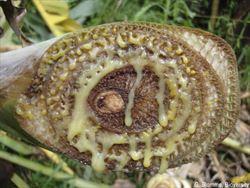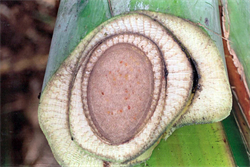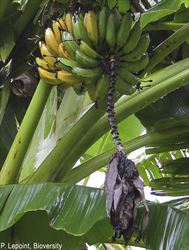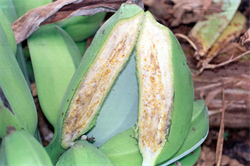Banana xanthomonas wilt. It is also known as Xanthomonas wilt, banana bacterial wilt or enset wilt (enset, or false banana, is in the same family as banana, but used, almost exclusively in Ethiopia, for the starch of its rhizome and stem).
Pacific Pests, Pathogens, Weeds & Pesticides - Online edition
Pacific Pests, Pathogens, Weeds & Pesticides
Banana xanthomonas wilt (523)
Xanthomonas vasicola pv. musacearum; it was previously known as Xanthomonas campestris pv. musacearum. The abbreviation is BXW.
Africa. The bacterium was first reported in the 1930s in enset (false banana) an important staple crop in Ethiopia. It was later identifed there as xanthomonas wilt infecting both enset and banana. From Ethiopia is has spread to bananas in East and Central Africa: Burundi, Democratic Republic of Congo, Kenya, Rwanda, Tanzania, and Uganda. It is not present in Oceania.
Banana, and enset and its wild varieties. Most bananas are susceptolbe in East and Central Africa, especially ABB* varieties.
Originally, it was considered a disease of wild and cultivated enset. The bacterium causing the disease was thought to have evolved together on enset and confined to southern Ethiopia. Only occasionally was it a disease of banana. However, in 2001, it was found in bananas (AAA, AAB and ABB varieties) in central Uganda and it developed into an epidemic.
Symptoms depend on routes of infection:
Route (i): Suckers and mother plants. Suckers may already be infected at planting, when cut from an infected mother, or mother plants infected during pruning or harvesting; there is also a chance of soil infections, although these are uncertain. As suckers develop, internal infections cause the spear and other young leaves to turn yellow, fold in the centre and collapse. On older plants, the leaves turn yellow, wilt, break at the leaf bases, and hang down. Internally, when the stems (leaf sheaths) are cut, vascular tissues show various colours - cream, yellow or pink. Characteristically, the large air spaces in the leaf sheaths become filled with cream to pale yellow ooze (Photo 1). Sometimes symptoms are confined to the tissues at the centre of the stem, i.e., the fused petioles or leaf stalks (Photo 2).
Route (ii): Flowers. Signs of infection of a different kind occur on the flowers and fruits. The purple leaves (bracts) of the male flower bud ('bell') shrivel, turn black and die; later, some of the f
ruits show premature ripening - individual bananas turn yellow while others in the bunch remain green (Photo 3). When cut open, the fruits show rusty dark stains in the pulp, and yellow-orange vascular tissues (Photo 4). Even those that are green may show similar symptoms (Photo 5). The affected fruits quickly blacken and eventually the whole bunch decays.Spread of the bacterium over relatively short distances occurs when knives, contaminated with the bacterium, are used to remove suckers for replanting or to cut off bunches at harvest. Insects, too, are important - stingless bees, honeybees, wasps, fruit flies (Drosophilidae), and grass flies (Chloropidae) - moving between diseased and healthy flowers, attracted by nectar oozing from scars left by fallen male flowers and the leaf-like bracts that cover them.
Long distance spread is in suckers or seed pieces that show no symptoms of infection. Similarly, fruit with internal rots are marketed as they also appear healthy. Survival is in soil and plant remains, although for how long is not clear. Some reports suggest it may be for a maximum of 35 days.
The impact of the disease both on enset in Ethiopia and banana in Uganda, and other East African countries, is likely to have severe economic and social consequences. It is a highly damaging disease affecting all types and varieties of bananas. Plants and fruits are destroyed. Most information about impact comes from Uganda, where the disease has caused the biggest losses, in some areas reducing production by more than 90% in a year. Between 2001 and 2004 yields in central Uganda fell by 30-52%. The impact on biodiversity is unknown, but it is expected to reduce or alter the range of varieties grown.
Look for the shrivelling of the leaves on the male flower bud that turn black, or premature ripening of fruit on a bunch that otherwise remains green. On older plants, look for yellowing and collapsing leaves, and internal discolouration of the vascular tissues. Also, cut the flower above the male parts, let the milky sap discharge for 10-15 mins - this is normal - and look for yellow or brownish bacterial ooze. As there are several other bacterial that can cause banana wilts, identification should be done using molecular methods, especially if definitive identification is required as a basis for eradication, for instance.
A fungus disease of banana, known as Fusarium wilt or Panama disease (see Fact Sheet no. 176), also causes yellowing but on older leaves. The leaf blade does not become limp and the yellowing is much brighter compared to BXW, and the fruit develops normally. The most distinctive symptom of Fusarium wilt is a dark staining inside the stem, which is absent in bananas with bacterial wilt, and there is a lack of oozing from cut tissues.
BIOSECURITY
Countries where bananas are a staple, and as yet free from banana xanthomonas wilt, are extremely vulnerable to this disease, especially those of East Africa. It is difficult to control movement of bananas across borders, even where regulations exist, but the need for quarantines and prevention of movement of fruits and plant parts from infected to clean areas is crucial for disease control. In their absence, surveillance, the ability to make rapid diagnoses, and plans for eradication are the best approaches.
Where official transfers of banana, including its wild hosts, are required, these should follow the FAO/IBPGR Technical Guidelines for the Safe Movement of Germplasm. No. 15. Musa. 2nd Edition, (http://www.bioversityinternational.org/uploads/tx_news/Musa_spp.__2nd_edition__502.pdf). These state that germplasm should be transferred as virus-indexed plantlets growing in a sterile tissue culture medium.
CULTURAL CONTROL
For smallholders, many of the recommendations below are unlikely to be followed due to costs or other resource limitations. However, the most important are (i) monitoring, and removal of disease plants as soon as they are seen, (ii) removal of unopened male flower buds (called 'de-budding') with forked stick, and (iii) the need to keep cutting tools clean and free from bacteria. These three should be prioritised by extension services.
Before planting:
- Use only disease-free planting material; never plant cuttings that are: (i) from plants that you have not monitored, especially from neighbours, markets, unknown sources; and (ii) never plant suckers from an infected plant.
- Ideally, start plantings with government stock, if there is a banana disease certification scheme locally.
- Do not plant near plots that have the disease; above all, do not plant suckers down-wind from diseased plants, otherwise bacteria will be spread easily by insects from diseased to healthy plants.
During growth:
- Limit access by animals, workers, visitors and vehicles into banana fields, especially if there are disease outbreaks.
- Remove male buds immediately after the last hand emerges. Ideally, a forked stick should be used to twist the male bud and remove it, rather than cutting it off with a machete that might be contaminated with bacteria.
- Bag the inflorescence after emergence with polyethylene, muslin, nylon or mesh bags. These can be removed after fruit set if the male buds are also removed.
- Check (monitor) farms frequently for symptoms of xanthomonas bacterial wilt and, where found, remove diseased plants. Recent recommendations suggest to remove only infected plants, not the entire mat. Do the following:
- Destroy diseased plants by injecting with herbicides or by cutting them out at soil level, leaving the suckers to grow; this method relies on the failure of the bacterium to colonise all the suckers systematically. Bury or when dry, burn the diseased plants, including infected fruits, on site.
- Clean tools (especially knives used for de-suckering and removing diseased plants) and machinery with bleach (dilute one part household bleach with three parts water), clean soil from footwear.
- Dig a trench around diseased plants to retain run-off rain water.
After harvest:
- Carry on monitoring and treating plants if symptoms are seen.
- If actions fail to control the disease, grow alternative crops, fallow the land, or plant a legume cover crop, such as Mucuna for 6-12 months.
RESISTENT VARIETIES
All the cultivars in Uganda are susceptible to natural infection, but differences between varieties in persistence of male bracts or absence of male bud do exist, allowing them to escape insect infection, but they are still susceptible to infection through contaminated tools. Pisang Awak and Bluggoe (ABB types), which attract many insects are more susceptible than other varieties. Consequently, Bioversity International is evaluating types (AA, AAA, AAB, ABB) in East African countries with persistent bracts and flowers as alternatives to susceptible ABB varieties. Conventional breeding is being done by IITA (International Institute of Tropical Agriculture), and genetic engineering is being attempted with the insertion of two genes from capsicum into East African bananas.
CHEMICAL CONTROL
Not a method to use for the control of this disease.
AUTHOR Grahame Jackson
Information from Blomme G, et al. (2017) Bacterial diseases of banana and enset: Current state of knowledge and integrated approaches toward sustainable management. Frontiers in Plant Science. (https://www.frontiersin.org/articles/10.3389/fpls.2017.01290/full#B66); and Drenth A, Kema G (2021) The vulnerability of bananas to globally energing disease threrats. Phytopathology 111: 2146-2161; and CABI (2021) Xanthomonas campestris pv. musearum (banana xanthomonas wilt (BXW)). Crop Protection Compendium. (https://www.cabi.org/cpc/datasheet/56917); and Vezina A (2020) Xanthomonas vesicola pv. musacearum (2020). Musapedia, the banana knowledge compendium. Promusa. Date of last modification: 22 September. (https://www.promusa.org/Xanthomonas+vasicola+pv.+musacearum); and from (and Photos 1&2) Xanthomonas wilt of banana. ProMusa. (https://www.promusa.org/Xanthomonas+wilt). Photo 1 Guy Blomme, Bioversity International. (https://www.musarama.org/photo-522-BXW_pseudostem_symptoms). Photos 2&3 Pascal Lepoint, Bioversity International. (https://www.musarama.org/photo-517-BXW_fruits_symptom). Photo 4 Banana sucker infected with Banana Xanthomonas Wilt in Uganda. (https://www.flickr.com/photos/iita-media-library/6755030657/in/photostream/). Photo 5 Banana fruits infected with Banana Xanthomonas Wilt in Uganda. (https://www.flickr.com/photos/iita-media-library/6755031667/in/photostream/).
Produced with support from the Australian Centre for International Agricultural Research under project HORT/2016/185: Responding to emerging pest and disease threats to horticulture in the Pacific islands, implemented by the University of Queensland, in association with the Pacific Community.
*The codes ABB and BBB are the amount of Musa acuninata and Musa bulbisiana (parents of many banana varieties grown) represented in each banana variety. An internationally recognised scoring system is used to determine the proportion.








